Viewing: Blog Posts Tagged with: cleaning, Most Recent at Top [Help]
Results 1 - 4 of 4
Blog: puddersputter (Login to Add to MyJacketFlap)
JacketFlap tags: Cleaning, Add a tag
Blog: The Well Dressed Librarian (Login to Add to MyJacketFlap)
JacketFlap tags: fashion advice, cleaning, jackets, cleaning, jackets, fashion advice, Add a tag
Often, adoring fans have asked me "How do you look so good all the time?" as if my job consisted of nothing more than sipping hot coffee and having the occasional cigarette. My job is dirty work. Building a library from a completely donated collection is dirty work. Much dirtier than I anticipated. So, I invested in a white lab jacket. Now I can clean my library, organize, move boxes - and still
Blog: Scribbled Business (Login to Add to MyJacketFlap)
JacketFlap tags: painting, cleaning, paint brush, care, brushes, Add a tag
When you step inside your favourite local art supply store it's hard not to be bombarded by the intense vast array of paintbrushes. I usually have to buy paintbrushes several times a year and usually have to buy them more frequently when I'm painting on rough surfaces (such as plywood or heavily gesso'd board) as the surface does lots of damage to the delicate tips...
So, what's the difference between different kinds of brushes? First of all there's two main distinctions: Natural bristle and synthetic. Natural haired paintbrushes can come from a variety of animals including Weasles, Oxen, Goats, Ponies & Squirrels (and camel does not mean it is made from camel hair but rather an all-encompassing brush made of many types of hair). Synthetic hair brushes simply mean that the hair is manufactured. Natural is often best for watercolour and synthetic for acrylics although I do not always follow these rules. I Often prefer natural brushes for the acrylic wash work I do as I find the brush head lasts longer.
When choosing your next paintbrush consider these following tips:
1) What are you painting with? (acrylic, watercolour, ink, etc)
2) What are you painting on? (is it rough or smooth)
3) Your desired effect... (texture, or perfection?)
Natural Brushes:
Kolinsky: The finest red sable brushes. Ideal for watercolour: great absorbancy and strength
Red Sable (weasle): Oil & Watercolour: Holds a point well.
Goat: Inexpensive brush, very absorbant.
There are also stiff haired brushes (called Bristles, found in both synthetic and natural fibres, I personally enjoy natural more as they seem not to "grate" along surfaces), ideal for painting on fabric, textured materials, oils, acrylics and tempera. I love these brushes because no matter how ratty they get I never throw them away. I use them for dry brush work and thick acrylic paintings because the worse they get the more comfortable I seem to be with them.
The next thing to consider is if you will want a long handle or a short handled brush. I have lots of both but usually seem to hold my brushes close to the tip for most of my work. However, when painting on plywood I like to have big handled brushes so that I can sit farther away from my work. It helps to view things from far away and having a long handled brush will take lots of the walking back and forth out of the situation if you tend to paint from a chair (like I do).
*Historically short handled brushes are preferred by watercolourists and long handled brushes are for easle work.
How to take care of your paintbrushes:
I bought a cleaner from my local art supplies store (keep in mind to buy the right cleaner for the paint you are using). It's softer than soap as brushes can't take too many harsh chemicals before the hairs start falling out everywhere. My biggest reason I have to replace brushes is because I often forget my brushes in the little tub I wash them in for too long: Don't let them soak! They'll eventually get bent tips and you'll forever be cursing the curve of your brushes if you do this. Also: do not overload your brush as it isn't healthy for brushes to get crammed full of paint all the way up to the metal part (ferrule). This eventually rusts out the brushes and makes them stiff and gross. Who wants to be putting the final touch on a painting when suddenly a little bit of old crusty black ink comes oozing out... staining it for good! Of course the more obvious rule is to not allow paint to dry on your brush. It's very unhealthy for the brush to get scrubbed like a maniac to get all the paint out (even if you do get it all out your little brush will never be the same).
Finally store your brushes laying flat or upright. Never store them with bristles down or once again you'll get a nice crocked tip which will inevitably be very annoying.
The tip I heard lately to fix old brushes where the hair has seperated is to boil some water and let your brushes sit in there for a few minutes. If the brush isn't in too bad of shape it should repair itself... NEAT!
Good luck painting and love your brushes.
Blog: Through the Studio Door (Login to Add to MyJacketFlap)
JacketFlap tags: books, studio, cleaning, Add a tag
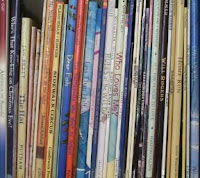 Along with my quest to becoming published, I'm embarking on another, and just as difficult, quest. Becoming organized! The spring cleaning bug bit. That nasty little bug jumped right from the house into my studio. It keeps nipping at me. Finding piles over here and stacks over there. Newspaper clippings hidden among photos. Pencils stubs too short to even grasp. Plastic containers with no real purpose. And books! Stacks of books everywhere! It was time for a plan.
Along with my quest to becoming published, I'm embarking on another, and just as difficult, quest. Becoming organized! The spring cleaning bug bit. That nasty little bug jumped right from the house into my studio. It keeps nipping at me. Finding piles over here and stacks over there. Newspaper clippings hidden among photos. Pencils stubs too short to even grasp. Plastic containers with no real purpose. And books! Stacks of books everywhere! It was time for a plan.
Ikea to the rescue! They have a cubicle style bookcase made just for me. I have cubbyholes for my copies and for the copies from each of the libraries I visit. And I can still stack, but hopefully keep things under control. Like all good organizers bitten by the spring cleaning bug, I started out by sorting everything alphabetically!



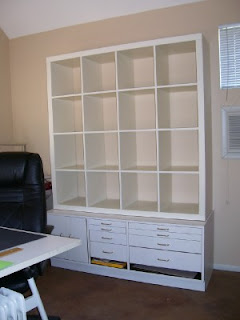
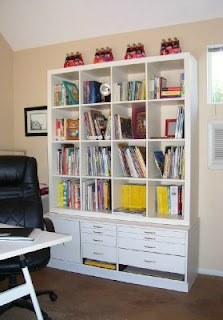

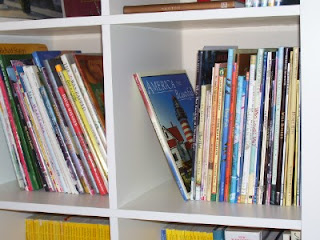
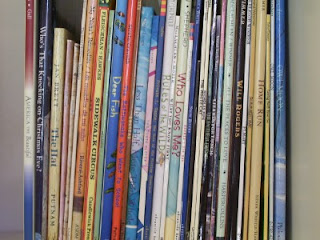
Oh GOODIE, another avid pb collector!
Love the new shelf.
=o)
Hey thanks for sharing about your bookshelf. As soon as I am done with this deadline, I am going to IKEA. That bookshelf is just what I have been looking for!
What a pretty room! I love the new book shelf - lucky!
Karen
Oh those signed copies... SIGH.... how beautiful they look all posed next to one another. Now you have inspired me to get really organized. I love your new look. You arranged your books in a lovely array of colors.
Wow, I think you've got just as many, if not more, pbs than I do.
Your place is just like a library now. Cool!
Thanks!! I do have a pretty good collection. And it's still growing. I've added a few more since this post. Not signed though...yet!
Wow! That looks amazing! You definitely need taller shelves when you collect picture books--or at least adjustable shelves!
I'm glad you stopped by my space. I'll keep dreaming about that library--stocked, of course, with my own masterpieces and those of all my blue boarding buddies!
Mary Ann